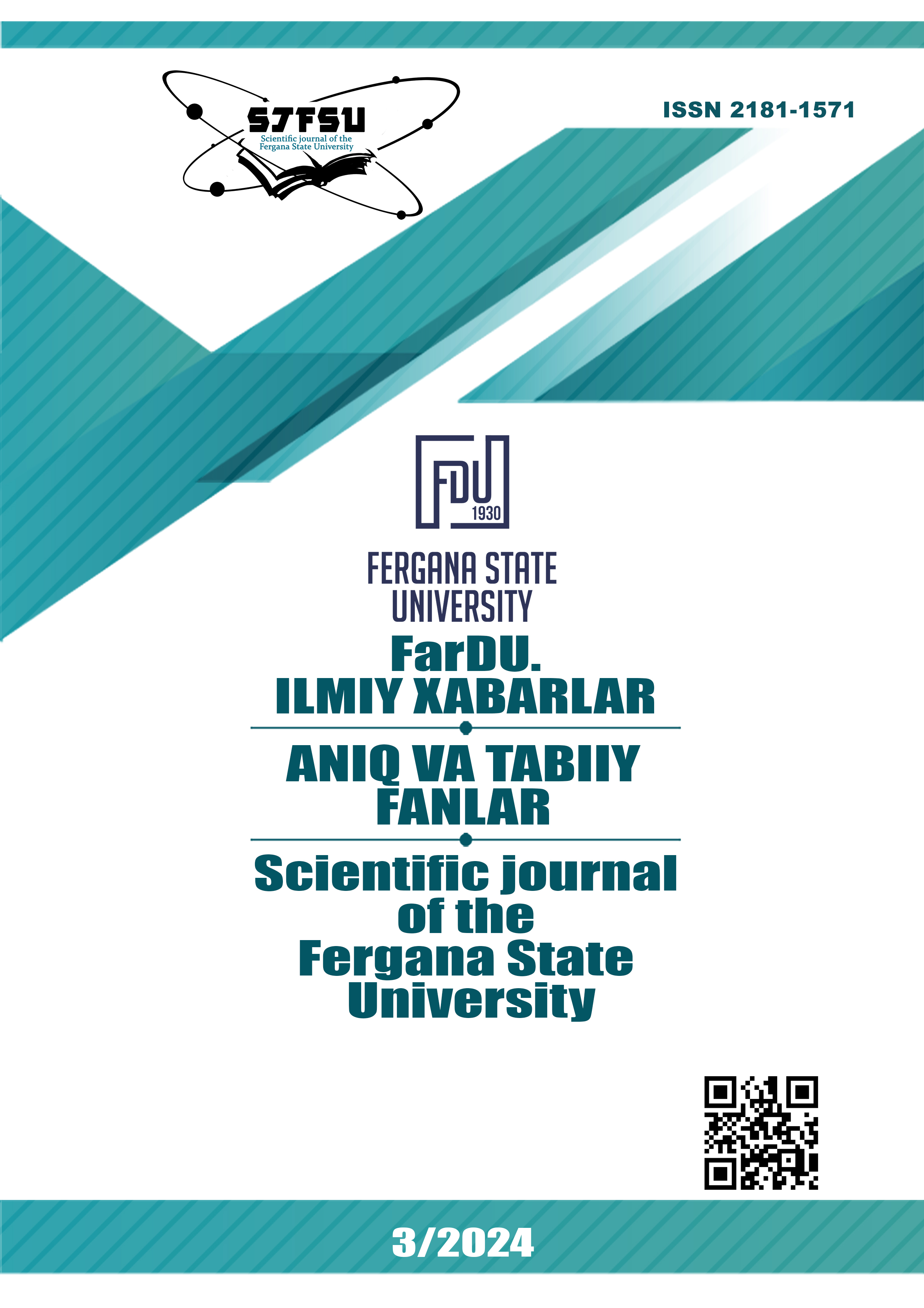DETERMINATION OF THE AMOUNT OF FLAVONOIDS IN PAULOWNIA AND ROSMARINUS PLANT LEAVES
Keywords:
Flavonoids, dihydroquercetin, rutin, salidroside, seneroside, luteinin, quercetin.Abstract
In this study, the flavonoids contained in the leaves of Paulownia and Rosmarinus, which were introduced to our country and grow in the territory of Fergana region, were studied by the HLPC method. According to the analysis of the results of the studied plant samples, it was found that they contain 6 types of flavonoids.
References
Pietta, P.G. Flavonoids as antioxidants. J. Nat. Prod. 2000, 63, 1035-1042.
Havsteen, B.H. The biochemistry and medical significance of the flavonoids. Pharmacol. Ther. 2002, 96, 67–202.
https://srcyrl.xjcistanche.com/news/basic-knowledge-of-flavonoids-and-the-effects-59143022.html.
Jakubowski, M.; Tomczas, A.; Jelonek, T.; Grzywiński, W. Wykorzystanie Drewna i Możliwości Uprawy Drzew z Rodzaju Paulownia. Acta Sci. Pol. 2018, 17, 291–297.
Xu, E.; Fan, G.; Niu, S.; Zhao, Z.; Deng, M.; Dong, Y. Transcriptome Wide Profiling and Expression Analysis of Diploid and Autotetraploid Paulownia tomentosa × Paulownia fortunei under Drought Stress. PloS ONE 2014, 9, e113313.
Icka, P.; Damo, R.; Icka, E. Paulownia tomentosa, a Fast Growing Timber. Ann. Valahia Univ. Targoviste Agric. 2016, 10, 14–19.
Islomov B.S., M.A.Hasanov. O‘simliklar introduksiyasi. Samarqand 2022.161 b.
Jordán M.J., Lax V., Rota M.C., Lorán S., Sotomayor J.A. (2013) Effect of bioclimatic area on the essential oil composition and antibacterial activity of Rosmarinus officinalis L. Food Control. 30: 463-468.
Downloads
Published
Issue
Section
License
Copyright (c) 2024 Scientific journal of the Fergana State University

This work is licensed under a Creative Commons Attribution-NonCommercial-NoDerivatives 4.0 International License.
How to Cite
Most read articles by the same author(s)
- Mamatqulova Surayyoxon Abdusamatovna, Asqarov Ibrohimjon Rahmonovich, STUDYING THE FLAVONOID COMPOSITION OF THE BIOLOGICAL SUPPLEMENT OF ANICE AND CILORANT , Scientific journal of the Fergana State University: No. 3 (2024): FarDU.Ilmiy xabarlar jurnali (Aniq va tabiiy fanlar)
- Asqarov Ibrohimjon Rahmonovich, Madinabonu Xamdamova, METHODS OF USING WHEAT BRAN IN THE TREATMENT OF SOME DISEASES , Scientific journal of the Fergana State University: No. 4 (2024): FarDU.Ilmiy xabarlar jurnali (Aniq va tabiiy fanlar)
- , , ANALYSIS OF WATER-SOLUBLE VITAMINS IN THE «AS RHEUM» FOOD ADDITIVE OBTAINED BASED ON THE COMBINATION OF ALLIUM ODORUM AND RHEUM , Scientific journal of the Fergana State University: No. 3 (2024): FarDU.Ilmiy xabarlar jurnali. Ilova to'plam (Aniq va tabiiy fanlar)
- Ibrohimjon Rahmonovich Asqarov, Mo‘minov Mo‘ydinjon Mo‘minovich, Umidjon Xusanov Shokirjonovich, CHEMICAL COMPOSITION OF GULKHYRI (ALTHAEA OFFICINALS L) PLANT, ELEMENT ANALYSIS OF GULKHYRI OIL AND ITS SIGNIFICANCE IN FOLK MEDICINE , Scientific journal of the Fergana State University: No. 1 (2023): Scientific journal of the Fergana State University (Exact and natural sciences)
- , , DETERMINATION OF ANTIOXIDANT ACTIVITY OF BIOLOGICALLY ACTIVE SUBSTANCES CONTAINED IN (PIMPINELLA ANISUM L) , Scientific journal of the Fergana State University: No. 5 (2023): FarDU ilmiy xabarlari jurnali (Aniq va tabiiy fanlar)
- Asqarov Ibrohimjon Rahmonovich, Inomidin Ilmidinovich Xomidov, CHEMICAL COMPOSITION OF THE FRUITS OF THE PLANT ZIZIPHUS JUJUBA AND THEIR APPLICATION IN FOLK MEDICINE , Scientific journal of the Fergana State University: No. 4 (2023): Scientific journal of the Fergana State University (Exact and natural sciences)
- , , , CHEMICAL COMPOSITION OF CERTAIN SYNTHETIC DRUGS USED IN KIDNEY AND URINARY BLADDER DISEASES , Scientific journal of the Fergana State University: No. 4 (2023): Scientific journal of the Fergana State University (Exact and natural sciences)
- Asqarov Ibrohimjon Rahmonovich, Ubaydullayev Komiljon Tursunboyevich, PROSPECTS OF USING SAFFRON IN THE TREATMENT OF PARKINSON'S DISEASE IN FOLK MEDICINE , Scientific journal of the Fergana State University: No. 1 (2023): Scientific journal of the Fergana State University (Exact and natural sciences)
- , , DETERMINATION OF THE QUANTITY OF VITAMINS CONTAINED IN HYPERICUM PERFORATUM , Scientific journal of the Fergana State University: No. 3 (2023): FarDU ilmiy xabarlari jurnali (Aniq va tabiiy fanlar)
- Ibrohimjon Rahmonovich Asqarov, DETERMINATION OF ANTIRADICAL ACTIVITY OF PLANT EXTRACTS , Scientific journal of the Fergana State University: No. 2 (2024): FarDU.Ilmiy xabarlar jurnali (Aniq va tabiiy fanlar)

